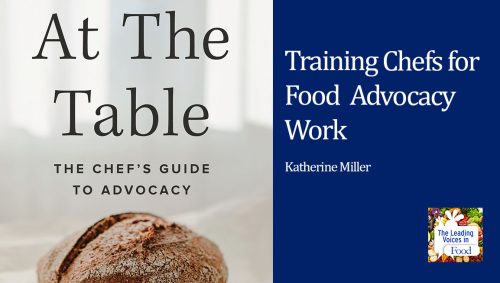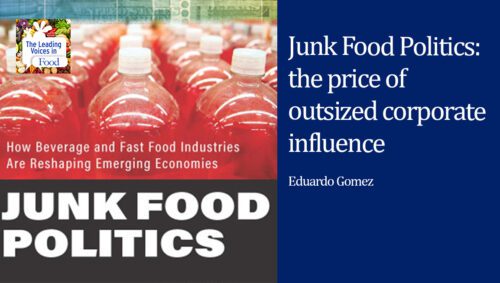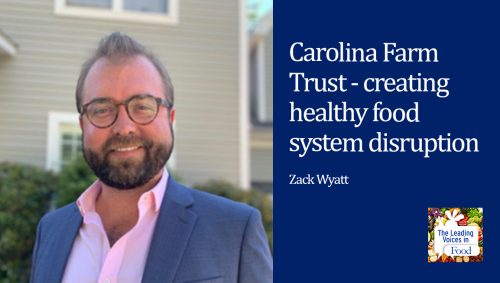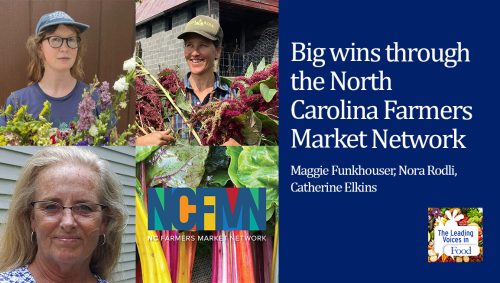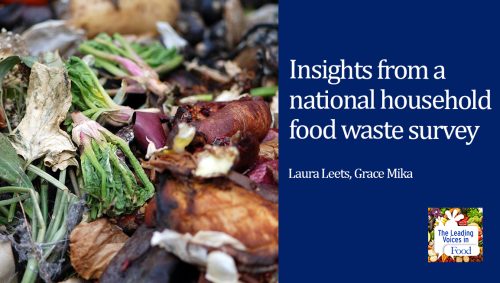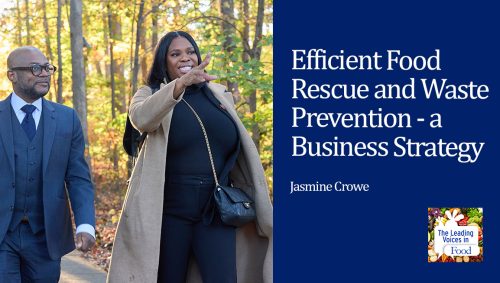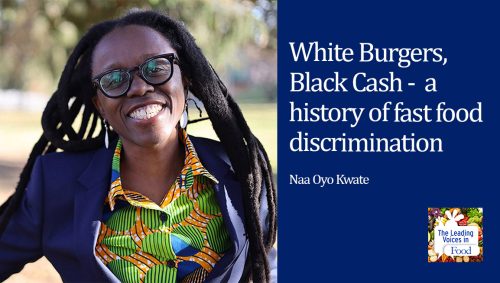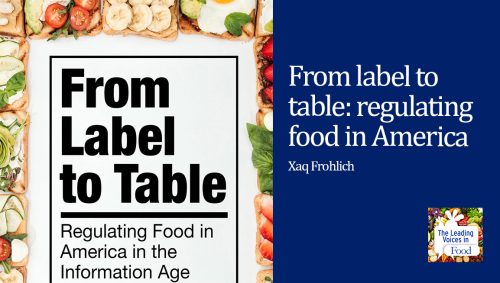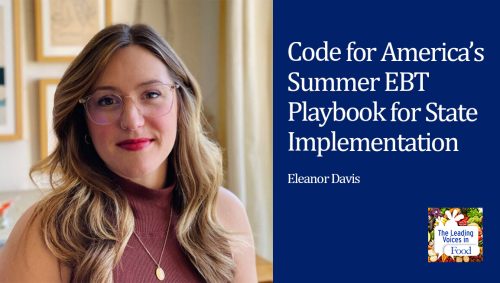The Leading Voices in Food
E158: CAFOs, Communities, and Alternatives to Industrial Agriculture
Are there models for livestock production that support both farmers and communities? Today, we’re going to explore the complex nature of relationships between farmers and nearby communities and the impact of industrial agricultural practices, such as CAFOs, stands for concentrated animal feeding operations, on those relationships. Our guests today are policy advocate Sarah Carden with Farm Action and community organizer Monica Brooks from the Maryland State Commission for Environmental Justice and Sustainable Communities.

Sarah Carden (she/her) joined Farm Action in December 2021. As Policy Advocate, she focuses her efforts on raising awareness and advocating for policies that meaningfully reform the nation’s food and agriculture system. Sarah holds a B.A. in Evolutionary Biology from Harvard University. She has been working on food system reforms for over a decade and brings expertise in local food systems and distribution networks, agriculture, non-profit development, and food entrepreneurship. Sarah has also worked as an organizer on two presidential campaigns and one congressional campaign. Sarah lives with her husband and their two young children on their organic vegetable farm.
Monica Brooks is a private citizen who serves on the Maryland State Commission for Environmental Justice and Sustainable Communities.
Interview Summary
Sarah, let’s begin with you. Can you tell us what is a CAFO?
Sarah: Sure. Let’s begin with the USDA definition. The USDA defines a CAFO as an intensive animal feeding operation in which over 1,000 animal units are confined for over 45 days a year. When we say animal unit, we mean the equivalent of 1,000 pounds of live animal weight. So a CAFO can house anywhere from hundreds to millions of animals. CAFOs are a part of the industrial agriculture system, which is controlled largely by multinational corporations. These corporations have been able to externalize their true costs – meaning they pass their production and distribution costs onto other entities. For example, farmers raise animals for corporate integrators according to a very strict contract in which the integrator has all the power and can set the terms of the agreement to maximize their own profits. In this relationship, the farmer is responsible for financing everything that depreciates in value, buildings, manure from animals, farm equipment. Meanwhile, the integrator owns the only thing that actually appreciates in value: the animals. CAFOs include both open feed lots for cattle, as well as huge buildings with no windows where livestock and poultry are confined, often in boxes or stalls. They produce huge amounts of animal sewage. Even the smallest CAFO produces an equivalent amount of waste as 16,000 humans. CAFO waste is usually not treated to remove pathogens and emits hazardous chemicals, such as ammonia, hydrogen sulfide, and methane. CAFOs destroy the air quality around them with particulate that carries disease-causing bacteria, fungus, or other pathogens. Animals frequently die in CAFOs, and their carcasses often, in large numbers, must be dealt with. Infestations of flies, rats, and other vermin are commonplace around CAFOs and, therefore, around CAFO neighbors.
So Sarah, thanks very much for that description, and I’m really happy that you address that issue of the integrators, the big agribusiness companies that control so much of the food supply chain, and so many people think the farmers are at fault for what goes on in these operations, and it’s discouraging how little control they have over it in many ways and, in fact, over their own livelihoods. So it was helpful to have your description. So Monica, can you describe what it’s like to live near CAFOs?
Sarah: Sure. Unfortunately, residents who have to live near CAFOs experience everything from an enormous amount of flies to ammonia in the air that can cause burning in the throat, burning in the skin, coughing, asthmatic conditions, not to mention all night and all day, you’re surrounded by large tractor trailers that are going up and down your highway at all hours of the night, lights flashing through your windows. You have feathers and all kinds of things on your property, and lastly, the main thing that happens is many of these people are on well water. Their wells lose water every time a CAFO moves in next door. So I’m talking about people who have actually had to, at their own expense, re-dig their own wells repeatedly just to have water for their families.
So it sounds like there are a number of things that range from being, I guess what you might call a nuisance to major things that could have big influences on health. And I know there’s an epidemiologist at Duke who’s done some very interesting work on the health consequences of living near CAFOs, and they’re really pretty significant, significant an understatement, actually. So let’s talk about activity on the ground and what happens in communities. So can you talk about what happened in your community when you found out that a number of CAFOs were approved to be built and what happened?
Monica: What of the things we’ve discovered in these rural communities, when you have a large industry, an agricultural industry as what we have here, is the agricultural industry seems to be able to get licensed to do things that the community may not approve of but the community is not informed. We found out that 13 football-size field CAFOs were coming to a small plot of land near our home, which was actually slotted to be placed on top of what’s called the Paleo Channel, which is our source of water. We’re on well water. And so our county thought, “This is a good idea for us to put 13 large CAFOs with manure that’s going to be coming out particulate matter, ammonia, nitrates on top of the source of water for residents.” There was this very tiny blurb in the paper about it. That was it. There were no hearings. There was no information disseminated to the community at all. When we got wind of it, we came together as a community, people who never knew each other before, all different walks of life, and we had to fight this on our own. We didn’t receive local support. We attended every council meeting. We spoke, we testified, we had town halls. You name it, we had it, until we received some support from some outside coalitions, Socially Responsible Agriculture Project, Food and Water Watch, and some attorneys for Earth Justice who were able to come alongside of us to give us that emphasis that we needed, and yet it took us three years in order to prevent this project from coming. We were successful and basically literally wearing down the prospective CAFO owner. However, it would’ve been really nice for us to have support from our legislators and our representatives, but you know what? This was a great opportunity for the citizens to show that there is power when we come together. There’s power, and we can bring about change and to go for what we want and in spite of us possibly being underdogs.
So Monica, do you have any advice or guidance for other communities who might be facing this kind of pressure from the big corporate agriculture interests?
Monica: Yes, I want to encourage you to know that, first, you’re not alone. Don’t be afraid to speak out. Mobilize your community. Connect with your neighbors. First go to your elected officials, and do whatever you can to ensure that these CAFOs don’t come to a neighborhood near you. You can do town halls. You can do protests. You can write letters. You can make all the noise in the media that you want. These kinds of things are what helped our community to become successful in fighting, but you can do it. Don’t be afraid to ask for outside help. There are several organizations all across the country that help in matters just like this, and you can be victorious. You can help get laws changed. You can help to bring better air and water and quality to your neighborhood.
Monica, thanks for that, and it’s really nice to know that community voices can be heard and that there are specific ways of making sure that takes place. So Sarah, back to you. Are there my models for livestock production that you believe support both farmers and communities, and would any alternative to CAFOs be able to feed enough people?
Sarah: Yes, and I’d like to echo what my colleague Dee Laninga said in a previous interview, and this is very important: “Industrial agriculture is not currently feeding the world. Smaller farms are doing that. The industrial Ag model is focused on producing feed for livestock, not food for people. It exports its meat products to wealthier countries, not to the world’s hungriest.”
So to answer your question about alternatives, they do exist. They have just never been given the same legislative, regulatory, and financial opportunities as big agribusiness. We need to prioritize policies and lending practices that will. So we need to deepen our local food economies, expand regional meat processing capabilities, give independent producers more pathways to the consumer. Robust local and regional food infrastructure includes things like convenient food hubs that distribute the wares of local producers, independent processing plants that serve local farmers and provide region with local sustainable healthy meat, community supported agriculture networks that provide the freshest produce from farm to nearby table, farmers who sell directly to consumers at markets, co-ops, and roadside stands, and grocery stores that recognize the fact that customers want to see the names of nearby farms in the produce, meat, and dairy sections. If industrial agriculture interests were required to internalize their costs and mitigate these risks, they would not be economically competitive with these alternatives. So if alternatives instead were prioritized in our policies, we could have a food system that not only stimulates the economy and operates within fair markets but also positively impacts health outcomes, the environment, and our social fabric.


